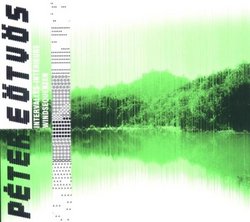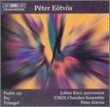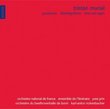| All Artists: Peter Eötvös, Klangforum Wien, UMZE Chamber Ensemble, Michael Svoboda Title: Péter Eötvös: Intervalles Interieurs / Windsequenzen Members Wishing: 0 Total Copies: 0 Label: Budapest Music Center Original Release Date: 7/6/2004 Release Date: 7/6/2004 Genres: International Music, Special Interest, Classical Styles: Experimental Music, Historical Periods, Modern, 20th, & 21st Century, Instruments, Electronic Number of Discs: 1 SwapaCD Credits: 1 |
Search - Peter Eötvös, Klangforum Wien, UMZE Chamber Ensemble :: Péter Eötvös: Intervalles Interieurs / Windsequenzen
 | Peter Eötvös, Klangforum Wien, UMZE Chamber Ensemble Péter Eötvös: Intervalles Interieurs / Windsequenzen Genres: International Music, Special Interest, Classical
|
Larger Image |
CD DetailsSimilar CDs |
CD ReviewsReal sensibility for the theatre,mixed electronics is wonder scarecrow | Chicago, Illinois United States | 04/08/2005 (5 out of 5 stars) "Eotvos in Hungary wrote hundreds of hours of music for film and theatre,but he also had a quick affinity for the avant-garde, attended Darmstadt Summer courses befreinding Stockhausen and coming the first to conduct his opera "Licht",later Eotvos went on to direct the Ensemble Intercontemporain, as well as visiting conductor appearances. He certainly has a wonderful technique for both composition and getting it off the ground, the Boulez paradigm that we need more musicians and interpreters for the new, the avant-garde, whatever it is called, than simply more composers(wordlwide),churning out hundreds of works a year that no one will ever hear.
Eotvos has a marvelous sense of the theatre and the power of the chamber orchestra, winds mixed with brass and percussion, now also electronic instruments are commonplace, as electric guitar,organ and electric bass and keyboards. I don't think the timbre of the traditional orchestra is suited for such 'interface' of electronic sound, there has to this day been an arduous problem in doing that. The chamber setting however corrects this,with focused timbre where the electronics is indeed fascinating for it comes to fill up the acoustic space also occupied in great means by winds brass and percussion. Eotvos is well versed in this genre, and has a nice sense of classic shape of things as in "Interfalles-Interieurs". This is a playful like work with trombone as soloist of sorts for a time,lots of almglochen, cowbells, hit with wood sticks for clarity and strings,clarinet,all electronically altered,this usually "smears" the timbres,and sustains them like catching a motor hum,an oscillation;this kind of gives an eery effect equivalent to swirling string harmonics,well "spectral harmonics" is the lingua franca in Paris at IRCAM,so this concern for the internal life of overtones has fascinated those IRCAMers; the trombones equivalent is focused lip tremoli,which is wonderful if the interval is not too large, usually a third. Percussion usually punctuate things in Eotvos make things come together or cohere. It is music always in search of some visual element, it is difficult to hear this music without theatre or video, for it really doesn't stand self-contained alone. There is too much simple sustained richly mixed timbres, loop like also at times, like a swirling oscillating toy space ship,with bugle calls emerging out of the welter of things with crescendoes,it is too playful for Wagner,more like poking fun at the military, toy soldiers at the service for venture capital,things, the music then coming louder then softer.It is the only place to go. The various players then are like actors, for the music is structured on "moments" Stockhausen's "Momente Form",where timbres are introduced into different places, measured frames, so the piece is like an assemblage going anywher without any one moment coming to dominate things, (Stravinsky's "Symphonies for Winds" is structured elegantly similar) The drones here as well are quite powerful and a means for the acoustincs to bounce from, like an abstract canvas where any form of dramatic incident can occur,like Twombly; we then,at some point remind ourselves what the hell happened to the acoustic instruments.They do return,with 'particles' of ideas,like contributing to the texture,here it is fairly clear,not really convoluted. This is a work from 1982 previously recorded with the Ensemble Intercontemporain who by comparison give the electronic sounds prominence. The genius of Eotvos's music is that it always magnifies itslef beyond what it is. It inhabits large spaces of duration, takes up lots of spaces, things take time to lift off,although his ideas are never intended to last more than minutes in conception. I can't help but hearing the influence of the late Luigi Nono, the affinity for the sustained sound, for "stasis" of means, where everything moves continuously, but really nothings really moves anywheres.So what happens in this Sartre-ian "situation" is that we are drawn toward just listening to the timbres, and how they transform themselves, like the ontology of timbre, "where does it go"?" |

 Track Listings (9) - Disc #1
Track Listings (9) - Disc #1


